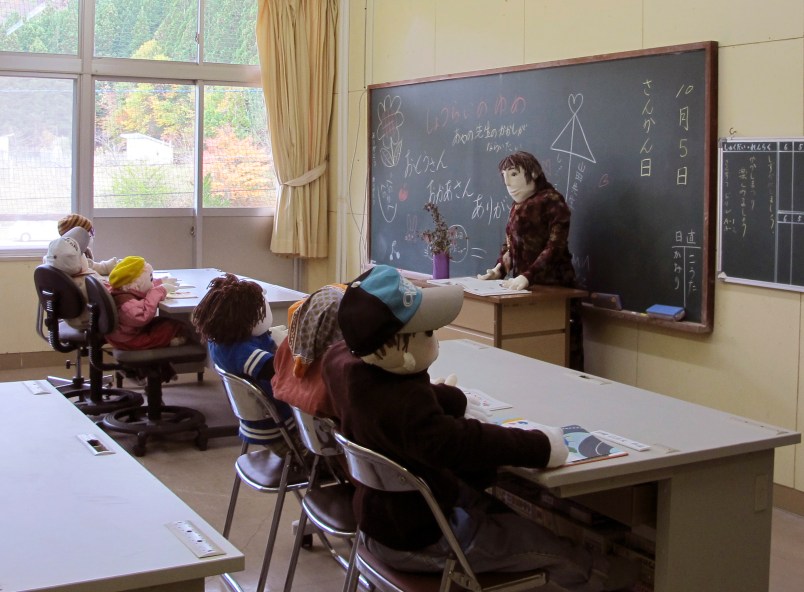NAGORO, Japan (AP) — This village deep in the rugged mountains of southern Japan once was home to hundreds of families. Now, only 35 people remain, outnumbered three-to-one by scarecrows that Tsukimi Ayano crafted to help fill the days and replace neighbors who died or moved away.
At 65, Ayano is one of the younger residents of Nagoro. She moved back from Osaka to look after her 85-year-old father after decades away.

“They bring back memories,” Ayano said of the life-sized dolls crowded into corners of her farmhouse home, perched on fences and trees, huddled side-by-side at a produce stall, the bus stop, anywhere a living person might stop to take a rest.
“That old lady used to come and chat and drink tea. That old man used to love to drink sake and tell stories. It reminds me of the old times, when they were still alive and well,” she said.
Even more than its fading status as an export superpower, Japan’s dwindling population may be its biggest challenge. More than 10,000 towns and villages in Japan are depopulated, the homes and infrastructure crumbling as the countryside empties thanks to the falling birthrate and rapid aging.
First the jobs go. Then the schools. Eventually, the electricity meters stop.

Neither Prime Minister Shinzo Abe’s ruling Liberal Democratic Party nor any of its rivals have figured out how to “revive localities,” an issue that has perplexed Japanese leaders for decades.
But local communities are trying various strategies for attracting younger residents, slowing if not reversing their decline. In Kamiyama, a farming community closer to the regional capital, community organizers have mapped out plans for attracting artists and high-tech companies.
Nagoro is more typical of the thousands of communities that are turning into ghost towns or at best, open-air museums, frozen in time.

The one-street town is mostly abandoned, its shops and homes permanently shuttered.
The closure of the local elementary school two years ago was the last straw. Ayano unlocks the door and guides visitors through spotless classrooms populated with scarecrow students and teachers.
When she returned to her hometown 13 years ago, Ayano tried farming. Thinking her radish seeds may have been eaten by crows, she decided to make some scarecrows. Now there are more 100 scattered around Nagoro and nearby towns.
Like handcarved Buddhist sculptures, each has its own whimsical expression. Some sleep, their eyelids permanently shut. Others cuddle toddler scarecrows or man plows and hoes.

Ayano brings one along for company on her 90-minute drive to buy groceries in the nearest big town. But most remain behind, to be photographed and marveled at by tourists who detour through the winding mountain roads.
“If I hadn’t made these scarecrows, people would just drive right by,” said Ayano.
The plight of Japan’s countryside is partly a consequence of the country’s economic success. As Japan grew increasingly affluent after World War II, younger Japanese flooded into the cities to fill jobs in factories and service industries, leaving their elders to tend small farms.
Greater Tokyo, with more than 37 million people and Osaka-Kobe, with 11.5 million, account for nearly 40 percent of the country’s 127 million people.
“There’s been this huge sucking sound as the countryside is emptied out,” said Joel Cohen, a professor at Columbia University’s Laboratory of Populations.
Japan’s population began to decline in 2010 from a peak of 128 million. Without a drastic increase in the birthrate or a loosening of the staunch Japanese resistance to immigration, it is forecast to fall to 108 million by 2050 and to 87 million by 2060. By then, four in 10 Japanese will be over 65 years old.

The population of Miyoshi, which is the town closest to Nagoro, fell from 45,340 in 1985 to about 27,000 last year. A quarter of its population is over 75 years old. To entice residents to have more children, the town began offering free nursery care for third children, free diapers and formula to age 2 and free health care through junior high school.
“The way to stop this is to get people to have more babies,” said mayor Seiichi Kurokawa. “Apart from that, we need for people to return here or move here.”
But it’s not an easy sell, despite the fresh air and abundant space.
“You can’t just grab people by the necks like kittens and drag them here,” Kurokawa said.
Getting residents of half-empty towns to accept newcomers can also be a challenge.

In Kamiyama, to the east, the town still struggles to convince owners who are often relatives living in distant cities to open up abandoned homes for rent or renovation, said Shinya Ominami, chairman of a civic group that has led efforts to revive the town.
In a briefing for potential investors and visiting officials, Ominami shows a slide of the town’s shopping street, dotted with houses that are empty, and then another with some of the buildings filled with new businesses — a bistro, a design studio, an IT incubation hub.
“Once we accept this is the reality, we can figure out how to cope with it,” Ominami said.
___
Emily Wang contributed to this report.
Copyright 2014 The Associated Press. All rights reserved. This material may not be published, broadcast, rewritten or redistributed.









